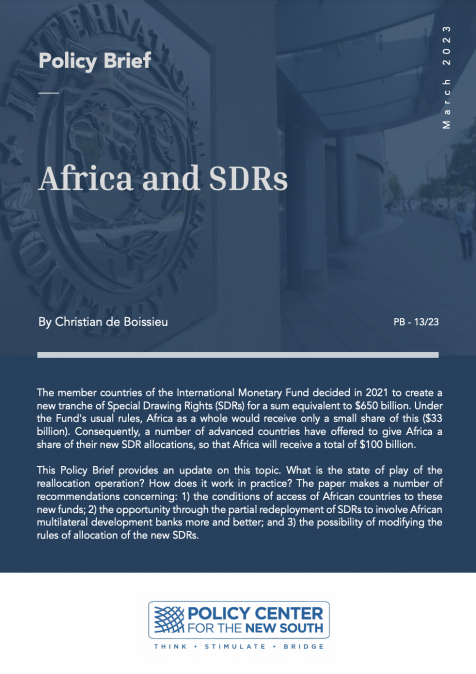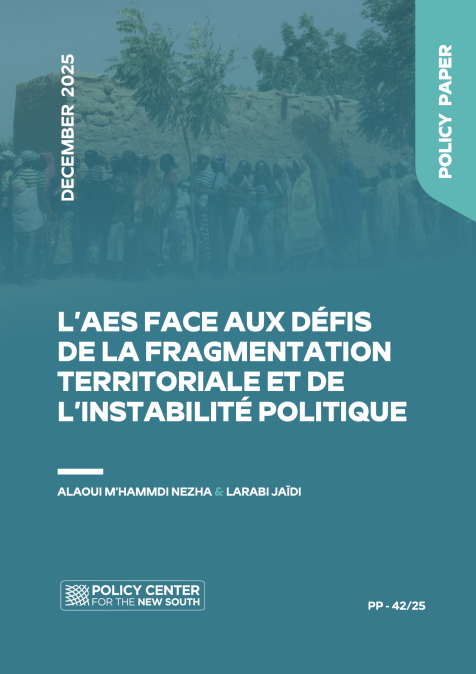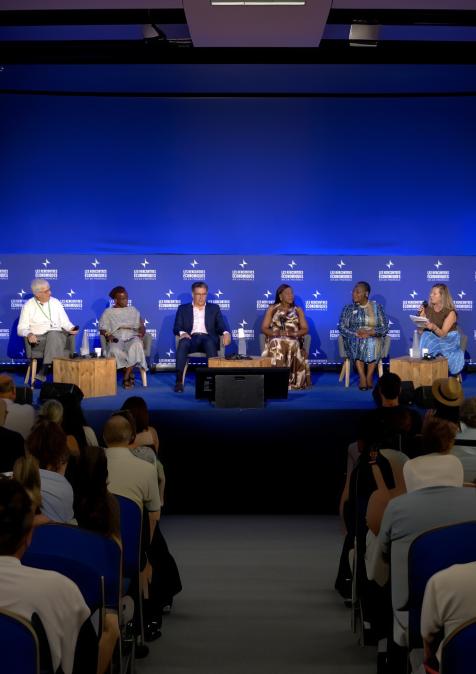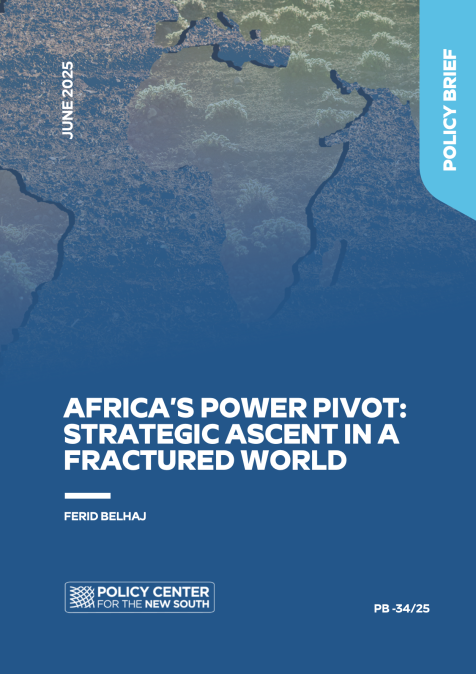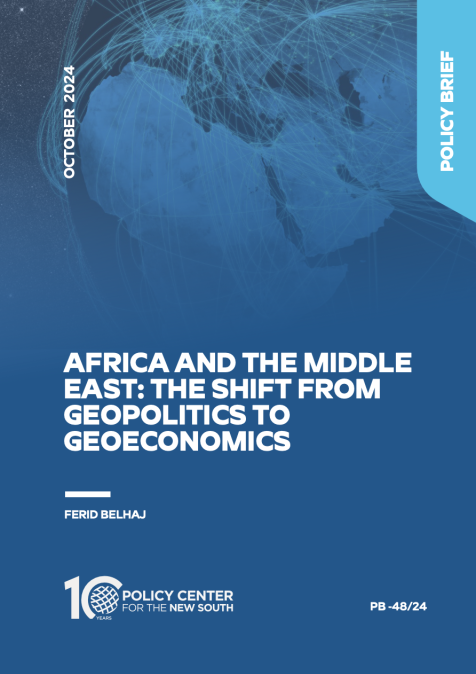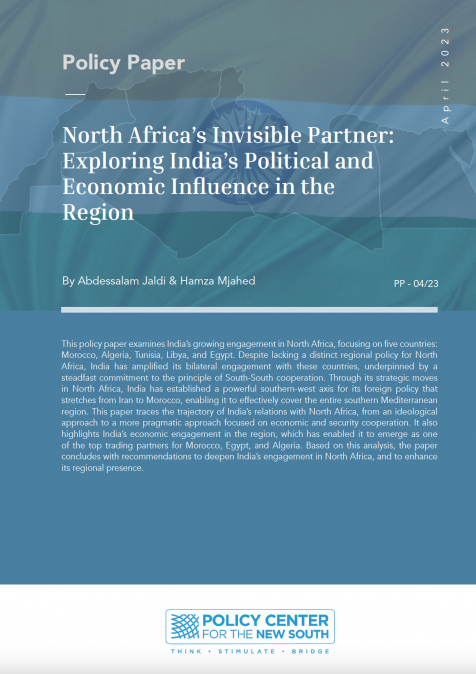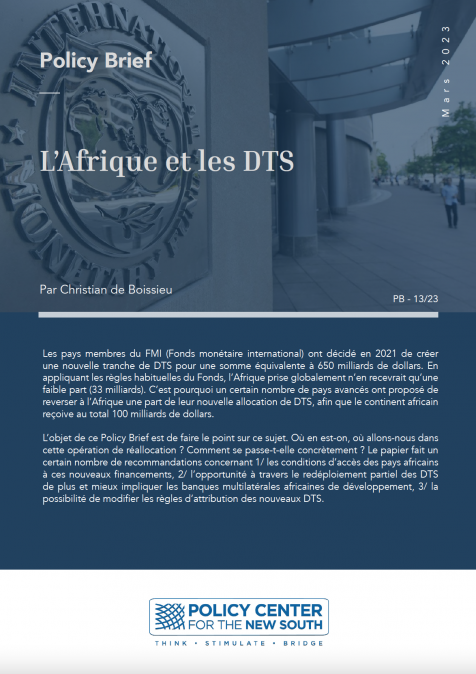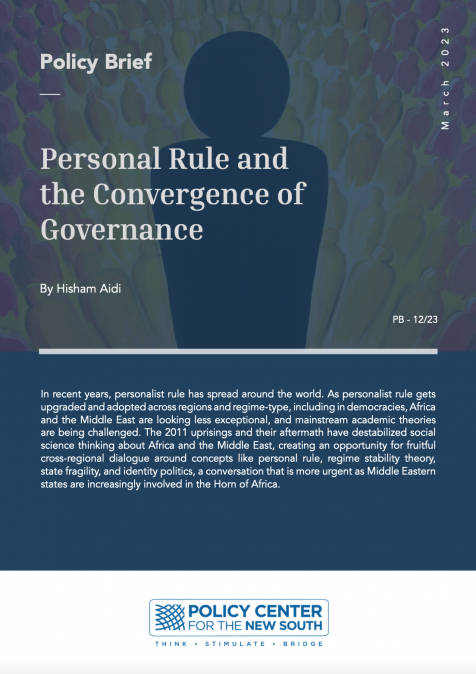Publications /
Policy Brief
The member countries of the International Monetary Fund decided in 2021 to create a new tranche of Special Drawing Rights (SDRs) for a sum equivalent to $650 billion. Under the Fund's usual rules, Africa as a whole would receive only a small share of this ($33 billion). Consequently, a number of advanced countries have offered to give Africa a share of their new SDR allocations, so that Africa will receive a total of $100 billion.
This Policy Brief provides an update on this topic. What is the state of play of the reallocation operation? How does it work in practice? The paper makes a number of recommendations concerning: 1) the conditions of access of African countries to these new funds; 2) the opportunity through the partial redeployment of SDRs to involve African multilateral development banks more and better; and 3) the possibility of modifying the rules of allocation of the new SDRs.
INTRODUCTION
In August 2021, the International Monetary Fund approved a new allocation of Special Drawing Rights (SDRs) for an amount equivalent to $650 billion. This is the fourth and largest allocation since the creation of SDRs in 1969. By comparison, the 2009 plan, adopted after the onset of the 2007-2008 global financial crisis, amounted to only 40% of the August 2021 plan.
There were several justifications for the size of this new allocation: the COVID-19 pandemic and access to new financing to deal with it; the financing of growth and development after the almost general recession of 2020 that came about because of the health crisis; the climate crisis and the imperative of the energy and ecological transition. The war in Ukraine started in February 2022, well after the decision on this new SDR allocation. But the war’s global impact on energy and food prices has made the allocation even more essential.
This amount of $650 billion is both significant in absolute terms and moderate in relative terms, since it represented 0.6% of the world's GDP in 2021. One might be tempted to compare this modest amount with the flood of liquidity poured in by central banks since 2009 under unconventional monetary policies (‘quantitative easing’), and the resulting explosion of these central banks’ balance sheets. But the comparison is not necessarily useful. Many NGOs would have liked to see a broader creation of new SDRs. But staying at the stated level was also a way to overcome the reluctance of the U.S. Congress, which is often quite reluctant to deal with anything related to the IMF and development-finance issues.
The central debate is less about the overall level of the allocation than about its distribution among IMF member countries. The general principle applied to SDR injections since their creation, and derived from the Fund’s Articles of Agreement, is clear, almost too clear: SDR allocations are distributed among members according to the quota of each country in the Fund, a quota itself calculated on the basis of several macroeconomic criteria, primarily GDP. This distribution key has the merit of being simple. It has the major disadvantage of creating a virtuous circle from which advanced countries benefit (wealth begets wealth, access to liquidity becomes cumulative for these advanced countries via their SDR holdings), and symmetrically low-income countries (LICs), especially in Africa, find themselves caught in a vicious circle: their financing constraints are only marginally eased by the creation of new SDRs.
To correct for such distributional effects, which only accentuate the gaps between advanced countries and LICs, some G7 countries have proposed that, as of 2021, part of their new SDR allocations should be returned to LICs. In this Note, we take stock, and discuss the means and conditions of such a redeployment, before drawing out some recommendations.
THE STATE OF PLAY
Spontaneously, i.e. before any reallocation, Africa as a whole was to receive an amount of SDRs equivalent to $33 billion, i.e. about 5% of the new tranche. This would be a little more than the share of African GDP in world GDP (around 3%), but obviously much less than the share of Africa's population in the world population. Before reallocation, this $33 billion was, according to the principle of proportionality, allocated to South Africa ($4.3 billion), Nigeria ($3.5 billion), Egypt ($2.9 billion), the Democratic Republic of Congo ($1.5 billion), and Morocco ($1.3 billion), with the others sharing the rest. As for the G7 countries, they would receive $283 billion of the $650 billion, and the high-income countries would receive an allocation of $438 billion.
Africa has been affected by the pandemic, with complicated and random access to the most credible vaccines, despite a young population that is less exposed than others to the deadly consequences of COVID-19. Africa’s healthcare systems have shown their inadequacy. Furthermore, Africa is especially exposed to the effects of climate change, the consequences of the war in Ukraine on energy prices (for importing countries) and food prices (for all), and the constraints and financing needs related to the energy transition. Africa must also improve health systems, and finance education and training—in other words, take charge of the production of common goods with adequate funding. I believe there is broad agreement on the redeployment of a significant share of the new SDR tranche to LICs, and even to some middle-income countries.
In view of the small amount earmarked for Africa, and upromoted by countries including France, Canada, and the United Kingdom, a target of $100 billion for Africa was set for 2021. A simple calculation shows that in order to reach this figure, it is necessary and sufficient that all high-income countries pay 20% of their new SDR allocations to Africa. The 20% redistribution rate was not given a priori, but was the solution to the equation to be solved to reach the $100 billion. Overall, countries are progressively getting closer to the goal. The amount of the African endowment stood at $45 billion in November 2021, and $60 billion in February 2022, according to information from the IMF Managing Director. As of February 2023, is moving cautiously on the issue.. These numbers are pledges on the donor side. For technical or institutional reasons, there may be a significant delay between the announced transfer and its effective date.
$100 billion may seem marginal compared to the debt and financing needs of African countries. The IMF estimated in 2021 that $425 billion was needed for African countries to meet the main challenges they face. This estimate that should be revised upwards in 2023 if the consequences for the African continent of the war in Ukraine are included. The $100 billion is marginal also compared to the outflow of capital from Africa following the monetary tightening in the countries of the North since 2021-2022 (on the part of the Federal Reserve, the European Central Bank, and the other central banks of the advanced countries). In fact, the $100 billion figure is more a symbol of North/South support and solidarity. This is a welcome gesture in times of pandemics, inflation, global warming, and the fight against terrorism. Such a sum should be taken as a clear and appreciable signal, which was absent in the three previous tranches of new SDRs (especially the first ones). All of this can only change marginally the financing equations and the conditions of adjustment between savings and investment for African countries.
On a country-by-country basis, Canada, the United Kingdom, and France stick strictly to the 20% reallocation rate. Together, these three countries have transfered $14 billion to Africa. Japan has a 10% reallocation rate (or $4 billion), while China has committed $10 billion. Germany is reluctant to accept anything that could be construed as monetary creation that is not backed by a priori and with certainty by an impact on the real economy (investment, growth, employment), and is hesitant. This is why it decided to contribute to the trust funds through which the recycled SDRs are channeled, not from its own SDR allocation, but from budgetary resources. As for the United States, it has decided to contribute funds, but without seeking to respect the recommended ratio of 20%. The U.S. Senate, although controlled by the Democrats (but, on these issues, is there in practice much difference between Republicans and Democrats? is moving cautiously on the issue. Full participation by the U.S. would be enough to reach the $100 billion target.
IMPLEMENTATION CHALLENGES
Two main reasons were put forward initially for SDRs: 1) fear of a shortage of international liquidity and the desire to supplement dollar liquidity, at a time when the international monetary system was still, August 1971, a system of gold exchange standards. The original idea was to increase international liquidity to support global growth; and 2) the desire to reduce the international role of the dollar through the creation of the new financial instrument, the SDR.
Are these two arguments still relevant? The potential or actual shortage of international liquidity has given way to a situation of great abundance: multiplication of access windows to financing from the IMF, depending on the case, with or without conditionality; exponential growth of the global money supply (though this is a concept more than a statistic) with, from 2009, unconventional monetary policies (QE) and the explosion of the balance sheets of the Fed, the Bce, and the other major central banks. The abundance of liquidity in the world today is not the cause (as in Milton Friedman's monetarist schemes), but the permissive, facilitating condition for the rebound of inflation, which comes mainly from energy and food prices. When speaking of abundant or even excessive liquidity at the global level, this does not in any way prejudge the diagnosis to be made according to regions and countries. Globally speaking, Africa, given its indebtedness and the flight of capital accentuated by the tightening of monetary policies in the North, needs access to liquidity in dollars and euros at partly concessional interest rates, precisely at a time when interest rates are rising all over the world in the short and long terms. The abundance of money at the macroeconomic level is accompanied by huge distribution effects between zones, plunging many African countries into situations of international liquidity shortage. This shortage cannot be ‘compensated’ for by accommodating or even lax domestic monetary policies. In fact, the opposite is true: domestic monetary laxity in emerging and developing countries, by fueling inflation, speculative attacks against the currency, and exchange rate depreciation, makes access to truly international liquidity more complicated.
As for the second argument, the goal of reducing the international role of the dollar through SDRs has not been achieved. The greenback still represents 60% of the foreign exchange reserves of the world’s central banks, a figure that has declined only slightly over the past twenty years. In the basket of five currencies (dollar, euro, pound sterling, yen, yuan) that make up the SDR, the weight of the dollar has even increased recently: from 41.7% at the time of the 2015 review, to 43.4% with the 2022 update, at the expense of the euro, yen, and pound sterling.
The SDR is defined and calculated as the basket of the five major currencies weighted by their respective roles. Is it a real currency? The answer to this question is not irrelevant for SDR recipient countries, since the possible use of this instrument depends on its status and role. Only if the beneficiaries of the allocation quickly exchange their SDRs for one of its components, for example for dollars, or for a currency not included in the basket, does the monetary ambiguity of the SDR gives way to monetary certainty, since each of the currencies included or not included in the basket is a real and complete currency because it performs all the traditional functions of money. The SDR remains today a hybrid financial instrument. As Michel Debré, then French Minister of Finance, said at the time, the SDR is like a zebra: black or white, in this case currency or non-monetary asset, depending on the angle adopted. Even if each new SDR tranche is part of a process of monetary creation almost ‘ex nihilo’— this additive phenomenon underlies the very creation of the instrument—the SDR remains a partial currency. It is backed by the IMF, which is not a central bank (contrary to what the Keynes plan suggested at the time). It certainly fulfills the function of a unit of account (for the accounting of the IMF, the World Bank, other development banks, etc.) and possibly that of a store of value. But it does not satisfy the central and specific function of money, that of acting as an intermediary between exchanges. This is why it seems impossible to rebuild the international monetary and financial system around the SDR as long as it remains defined as a basket of currencies. For many reasons, a basket currency is not intended to perform the function of intermediary between exchanges, for which, in terms of transaction costs, it is dominated by its components. The incessant composition-decomposition-recomposition of the basket generates high transaction costs, despite new technologies. So a basket currency risks remaining a partial currency. This was seen this in Europe with the ECU, a basket currency and partial currency, in place before the arrival of the euro, itself a complete currency.
SDRS TO FINANCE WHAT?
The accounting treatment of SDRs, in the accounts of the IMF and donor and recipient countries, gives rise to debates that are not always convincing and often byzantine. The ambiguity of the accounting solutions reflects the ambiguity of SDRs: is it money, credit, or non-monetary financial instrument? Rather than removing the uncertainty about the nature of the instrument, it is more interesting to focus on the economic role of the instrument. SDR recipient countries have a choice of uses:
One principle must be clearly stated and shared. It is up to the recipient African countries, not the IMF or donor countries, to choose how they use the SDRs they receive: either in one of the above three ways, or any combination they choose between these options, or other approaches not explained here. Not to respect this principle would be to go against the sovereignty of the recipient countries and, as a result, would severely restrict the usefulness of the whole system for them.
THE NEW SDRS: HOW AND UNDER WHAT CONDITIONS?
As long as the redeployment of SDRs does not involve a game of chess between the central banks of donor countries and the central banks of recipient countries, two main mechanisms can be envisaged: 1) giving the main role to the IMF and to special funds created within it; and 2) in a more decentralized way, putting African development banks at the center of the operation.
In practice, in the current SDR reallocation, both approaches are implemented. However, African development banks only intervene as a second resort. It is believed, for the reasons explained below, that their role should be increased for the smooth running of the current operation.
The IMF is quite jealous of its competence in the management of SDRs, which represent the reserve asset for which it is responsible. It is understandable that it wanted the bulk of the recycling of these SDRs to Africa to go through two trust funds that are directly linked to it:
The redeployment of part of the SDRs via these Funds raises a number of issues:
1) These funds grant loans to the beneficiaries, which results in additional indebtedness, whereas a grant formula could have been imagined for part of the reallocation. These donations are justified by the exceptional combination of systemic crises to which African countries, like others, have been and still are exposed, but to which African countries are more sensitive and vulnerable than others;
2) At what interest rates are the loans concerned granted? For what passes through the PRGT, the rate is zero, whereas the RST loans, in the long term, are subject to a positive rate linked to the interest rate on SDRs which mechanically follows the increase in the rates of the currencies in the basket;
3) What is the conditionality associated with the redeployment of SDRs? Here we see a major contradiction between the unconditional nature of the SDR as a liquid and reserve asset, and the conditionality of the IMF and its satellite trust funds, such as the PRGT and the RST. It is true that, as a result of crises and emergencies, IMF conditionality has diminished. It even disappeared, in the face of the COVID-19 health crisis, for certain rapid-disbursing assistance put in place in the emergency. As for what conditionality should remain in this redeployment of SDRs, which should largely do without it, Cabrillac and Guillaumont (2022) were right to insist on the adoption of macroeconomic conditions aimed at mitigating the vulnerability of the African countries concerned in the broad sense (economic, financial, energy, and climate vulnerability).
African development banks (including AfDB, BOAD, and the East African Development Bank) should be more intensively involved for a mixture of negative and positive reasons. One negative reason: the PRGT and RST have limited short-term absorptive and management capacities. It is estimated that the PRGT would be saturated at the threshold of the equivalent of $30 billion to be redeployed. The threshold for the just operational RST would be significantly lower. This means that the ‘IMF system’ could redeploy only a maximum of about $50 billion in the short term, and other complementary channels are thus needed to reach $100 billion. But there are also positive reasons to involve African development banks more and better in the redeployment operation:
(i) Increase their foreign exchange reserves. This is the option put forward by Kenya, for example. In this case, both the SDRs allocated directly and those obtained through reallocation are on the asset side of the balance sheet of the central bank of the recipient country. They result in an increase in the monetary base (central bank money corresponding roughly to the central bank’s balance sheet) and in the domestic money supply, unless the central bank decides to sterilize the monetary impact of the increase in its reserves by reducing correspondingly certain items on the asset side of its balance sheet. Access to these new reserves, given that the SDR is first and foremost a reserve asset, can, all things being equal, ease the external constraint and improve the rating of the recipient country. The total or partial sterilization of money creation is likely to indicate to investors and creditors the will to fight inflation. I am not insisting here on an aspect mentioned in 2021 and put forward by central banks of donor countries, with the effect (not necessarily the objective) of slowing down the reallocation or bending it in certain directions. One example among others: Christine Lagarde, the President of the European Central Bank, recalled at the time that, according to its statutes, the ECB is not able to dispose of the SDRs it receives. These SDRs would be, according to the ECB’s statutes or the interpretation given to them, inalienable. Fortunately, we have collectively found a way out of this narrow legalism by bypassing the central banks of donor countries with the blessing of their governments.
(ii) Increase the fiscal and budgetary policy space of the recipient countries. Because the same amount of money cannot be used twice, the SDR recipient country must choose between the direct monetary impact (i) and the direct fiscal impact (ii), based on the idea that in the end, and given the interplay of indirect effects, monetary and fiscal impacts necessarily interact. In order to respect the basis of the current reallocation to Africa, the increased budgetary margins must not be used to finance current expenditures. They should be used as a priority to finance investments, common goods (such as health and education), or to help finance the energy and ecological transition. In the spirit of this reallocation, the new budgetary margins must finance long-term public spending, rather than reducing public deficits. In many countries, these deficits must be reduced to sustainable levels. But this must be done through sustainable structural reforms, not through the ‘one-shot’ windfall of the partial reallocation of SDRs.
(iii) Help finance development. This route is possibly an application of the budgetary channel discussed in (ii), but it also mobilizes non-budgetary channels, such as financing from development banks. The indispensable role of these banks in the current operation will be discussed later
Other avenues, involving development banks in another way, can be mentioned. The new SDRs could also be used to finance guarantee funds set up either by certain African countries or at the subregional level (WAEMU, ECOWAS, CEMAC, etc.). Guarantee funds that would reduce the cost of debt for African countries, either directly or through credit enhancement operations. The concrete choice between the different modalities must be made primarily by the countries benefiting from the partial redistribution of SDRs.
SOME RECOMMENDATIONS
The process of partial redeployment of SDRs to African countries is underway. But already some recommendations are necessary in the light of the previous analysis:
-
The Poverty Reduction and Growth Trust (PRGT), established prior to COVID-19 and often called upon since 2019;
-
the Resilience and Sustainability Trust (RST), launched in April 2022, which can address some of the consequences of the war in Ukraine for recipient countries but is slow to become operational.
-
(i) These banks, given their proximity and geographic specialization, are better able than Washington institutions to assess the return and risk of SDR redeployment financing;
-
(ii) These banks, more and better than other financial institutions, have the capacity to ‘transform’ liquid assets such as SDRs or their counterpart in other currencies into long-term financing, required by and for the ecological transition, the digital revolution, and infrastructure in common goods, including health and education. More than commercial banks, and provided that banking regulations allow it, development banks in Africa as on other continents can and must engage in this maturity ‘transformation’ (mismatch) activity. This also implies that they have the means to manage the interest-rate risk arising from such a mismatch, and the configuration in which the average maturity of assets significantly exceeds the average maturity of liabilities on the development bank’s balance sheet;
-
(iii) The arrival of recycled SDRs will enable African development banks to generate the leverage that is typical in this type of configuration. It is estimated ex ante that the leverage could correspond to a multiplier of four. So, if these development banks raise $50 billion of the $100 billion pledged, they would be able to solicit private and other public financing to raise a total investment of $200 billion. If all possible financing remained at the level of the IMF, i.e. the PRGT and the RST, the leverage and spillover effect would not a priori play out with the same intensity;
-
(iv) Giving priority in the redeployment of SDRs to African development banks requires that they (AfDB, BOAD, BEAD for East Africa, etc.) play a complementary game with each other in this matter, not a competitive one.
Such a distinction can pose delicate problems of boundary between the two types of configuration, and therefore of implementation. But, learning from current experience, it would go in a direction that could combine considerations of efficiency and equity, which would be valuable enough to note.
-
1) It is essential to reach, without too much delay, the $100 billion promised to Africa. This is for financial reasons, of course, but above all as a demonstration of the solidarity of advanced countries with African countries in the face of the pandemic, the consequences of the war in Ukraine, and the climate crisis;
-
2) The conditions for access of African countries to this new financing must be quickly clarified and simplified;
-
3) This partial reallocation of SDRs is an opportunity to increase the role of the multilateral development banks competent on the African continent. The PRGT and RST, which operate within the orbit of the IMF, cannot and should not handle the bulk of this reallocation. A good balance could consist of dividing the management of this $100 billion once reached, into equal parts ($50 billion on each side) between, first, the PRGT and the RST, and second, the development banks;
-
4) The partial redeployment of SDRs to African countries must in no way be used as an argument by advanced countries to reduce their official development assistance (ODA) to the countries of the South. There should be an addition effect in the financial flows towards the latter, not a substitution effect. This is not a legal obligation, but more fundamentally an economic imperative in the interest of all, in the North as in the South, coupled with a moral obligation;
-
5) The reason for the reallocation was recalled at the outset: the fact that the new SDRs are allocated in proportion to the quotas of each member country in the IMF. Hence the vicious circles for LICs and some intermediate countries, and the virtuous circles for advanced countries. This situation is unsatisfactory and must be remedied, if necessary by amending the IMF's Articles of Agreement. This must be done preventively and pragmatically, because there are bound to be new SDR allocations in the future. In order to advance the debate, we make the following proposal:
-
or the creation of new SDRs is justified, as it has been several times in the past, by arguments relating to global monetary and financial macroeconomics: fear of a shortage of international liquidity, a desire to promote the SDR on the world stage by gradually strengthening its monetary role, etc. In these cases, we believe that the current rule for allocating new SDRs should be retained;
-
or the launch of new SDRs is justified mainly by the desire to manage shocks that are initially symmetrical (as in the case of COVID-19, a global shock), but which have asymmetrical effects because they affect the poorest countries even more, relatively speaking. In such cases, the rule for allocating the new SDRs would have to be changed, almost reversed, so that LICs, including almost all African countries, would benefit first.
-
-

